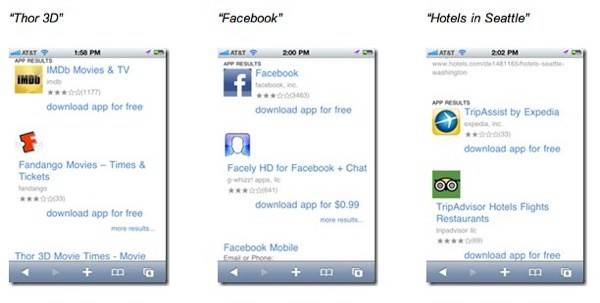Just because Microsoft has its own mobile operating system called Windows Phone 7, that doesn’t mean it’s above using the popularity of Apple’s iPhone to attract new users to its up-and-coming Bing search engine. For example, this week, the company highlighted a recently added Bing feature called “auto app discovery” by way of a company blog post that describes how the Microsoft search engine is a great tool for finding new iPhone applications.

Apps in Your Search Results
With Bing’s app discovery feature, normal Web searches will also return results for popular iPhone applications, even if you don’t specifically say “iPhone app” or “mobile app” or something similar in the text of your query.
That means a search for Facebook, for instance, will return the Facebook iPhone app, while a search for a movie may return apps like IMDb or Fandango.

When you explicitly search for iPhone apps, like a search for “top apps,” a category search or a search for a particular app name, the results will also include direct links to the app’s download page.

Not Just Integration with Bing Search Results, Search Within Apps, Too
The most interesting aspect of this new feature is Bing’s ability to actually launch your iPhone apps for you, from the search results. If you have the app installed on your iPhone already, in some cases, Bing will be able to launch the app and take you directly to the search results within the app itself.
In the example posted on Microsoft’s Bing Search blog, a query for “Thor 3D” provides a link to IMDb, as usual. But for those with IMDb installed, clicking “download” opens up the app on your iPhone, with a “Thor 3D” query already in place.

This is a unique use case for Bing, where it’s positioned as an app that aims to replace or augment the more basic app search options built right into the iPhone itself.
Microsoft Building for iPhone Users
It’s not unusual these days to see Microsoft build specifically for the iPhone. It’s already the maker of several iOS applications including OneNote, Windows Live Messenger, Photosynth, Tag Reader Bing and others. Notably, though, it has yet to launch a native Office for iPhone app.
This is also not the first time Microsoft has attempted to leverage the iPhone’s popularity for its own ends: in 2009, Microsoft promoted its new Visual Search feature, which lets you search by flipping through pictures, as yet another tool for iPhone app discovery.
But Bing builds for other mobile devices, too, besides iPhone. For example, this week Bing also launched an update to its mobile browser website at m.bing.com, which supports iPhone, Android and RIM devices running HTML5-compatible browsers. The update brings new features like Facebook sharing options, a news section for U.S. users, split views for maps, search history and trends and more.

In other words, why it initially may be attention grabbing to say “Microsoft” and “iPhone” in the same sentence – (How did this headline work for you, by the way? We had a little fun with that.) – it’s not odd, nor is it even a new move by Microsoft to build things for iPhone users. It’s just business as usual.




















